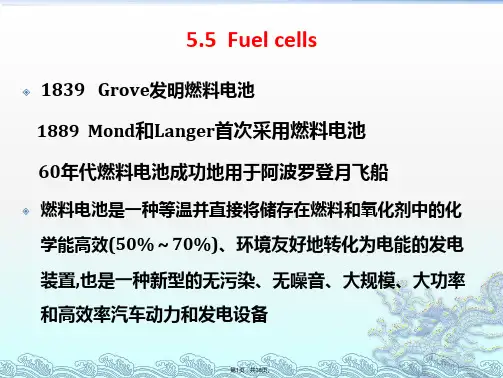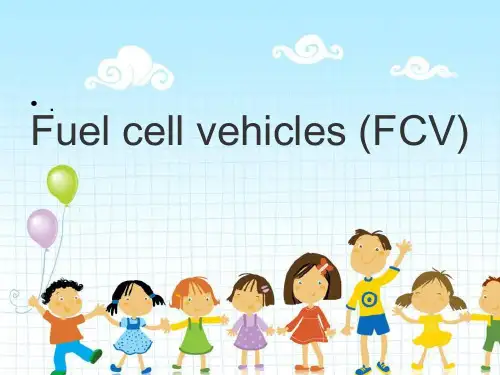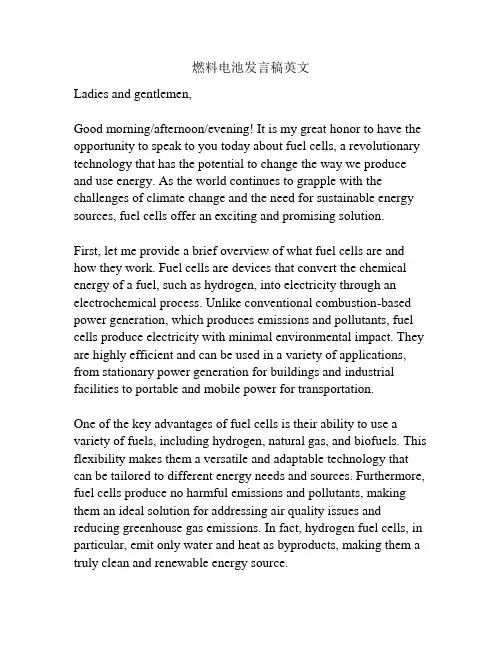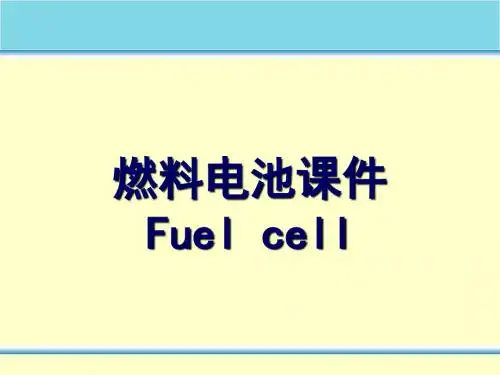燃料电池介绍英语ppt文稿
- 格式:docx
- 大小:15.92 KB
- 文档页数:2







燃料电池发言稿英文Ladies and gentlemen,Good morning/afternoon/evening! It is my great honor to have the opportunity to speak to you today about fuel cells, a revolutionary technology that has the potential to change the way we produce and use energy. As the world continues to grapple with the challenges of climate change and the need for sustainable energy sources, fuel cells offer an exciting and promising solution.First, let me provide a brief overview of what fuel cells are and how they work. Fuel cells are devices that convert the chemical energy of a fuel, such as hydrogen, into electricity through an electrochemical process. Unlike conventional combustion-based power generation, which produces emissions and pollutants, fuel cells produce electricity with minimal environmental impact. They are highly efficient and can be used in a variety of applications, from stationary power generation for buildings and industrial facilities to portable and mobile power for transportation.One of the key advantages of fuel cells is their ability to use a variety of fuels, including hydrogen, natural gas, and biofuels. This flexibility makes them a versatile and adaptable technology that can be tailored to different energy needs and sources. Furthermore, fuel cells produce no harmful emissions and pollutants, making them an ideal solution for addressing air quality issues and reducing greenhouse gas emissions. In fact, hydrogen fuel cells, in particular, emit only water and heat as byproducts, making them a truly clean and renewable energy source.In recent years, significant advancements have been made in fuel cell technology, leading to increased efficiency, lower costs, and improved performance. As a result, fuel cells are now being deployed in a wide range of applications, from power generation and backup power for critical infrastructure to transportation and material handling. These developments have created new opportunities for the widespread adoption of fuel cells and have sparked growing interest and investment in the technology.Let me now turn to the potential impact of fuel cells on the global energy landscape. With the increasing demand for clean and sustainable energy, fuel cells have the potential to play a critical role in diversifying our energy sources and reducing our reliance on fossil fuels. By providing a reliable and scalable alternative to traditional power generation, fuel cells can help to strengthen energy security, reduce energy costs, and promote economic development.Furthermore, fuel cells can serve as an important enabler of the transition to a hydrogen economy, in which hydrogen is used as a clean and renewable energy carrier. As interest in hydrogen grows, fueled by its potential applications in transportation, industry, and energy storage, fuel cells are poised to play a central role in the development of a hydrogen infrastructure. This infrastructure would support the production, distribution, and utilization of hydrogen, creating new opportunities for sustainable energy production and consumption.In addition to their environmental and economic benefits, fuel cells also have the potential to improve energy access and reliability inremote and off-grid areas. By providing a clean and reliable source of electricity, fuel cells can help to address the energy needs of communities that are not connected to the grid or are located in areas with limited access to traditional energy sources. This can have a significant impact on the quality of life and economic opportunities for these communities, while also contributing to the overall resilience of our energy systems.While the potential of fuel cells is clear, there are still challenges that need to be addressed in order to fully realize their benefits. These challenges include the need to further reduce the costs of fuel cell systems, expand the availability of hydrogen infrastructure, and improve the durability and performance of fuel cell technology. In addition, there is a need to address regulatory and policy barriers that can hinder the adoption of fuel cells and the development of a hydrogen economy.To overcome these challenges and unlock the full potential of fuel cells, collaboration and partnership between industry, government, academia, and other stakeholders are crucial. By working together to advance research and development, support the deployment of fuel cell technologies, and create an enabling policy environment, we can accelerate the transition to a more sustainable and resilient energy future.In conclusion, fuel cells have the potential to revolutionize the way we produce and use energy, offering a clean, efficient, and versatile solution that can address the challenges of climate change, air quality, and energy security. With continued innovation and investment, fuel cells can play a central role in the transition to amore sustainable and resilient energy system, creating new opportunities for economic growth, environmental stewardship, and energy access for all.Thank you for your attention, and I look forward to continuing the conversation about the exciting potential of fuel cells and the role they can play in shaping our energy future. Let's work together to realize this potential and build a more sustainable and prosperous world for future generations. Thank you.。




PEMFC——燃料电池课件PEMFC (Proton Exchange Membrane Fuel Cell) 燃料电池是一种将化学能直接转化为电能的设备,广泛用于用于汽车、航空航天和小型电子设备等领域。
它具有高能量转化效率、无污染排放和低噪音等优点,因此,PEMFC燃料电池在可再生能源和清洁能源技术的研究中扮演着重要的角色。
PEMFC燃料电池的核心是通过氢气和氧气的电化学反应来产生电能。
其中,阳极上的氢气在催化剂的作用下,电解为氢离子和电子。
氢离子穿过质子交换膜进入阴极,而电子则通过外部电路形成电流。
在阴极上,氧气与氢离子和电子发生反应,生成水蒸气。
整个反应过程无化石燃料燃烧产生的废气和有害物质的排放,只有清洁的水作为副产物。
PEMFC燃料电池相比传统的燃烧发动机具有很多优势。
首先,它具有高能量转化效率。
相较于内燃机的30%~40%的能量转化效率,PEMFC燃料电池可以达到50%~60%的能量转化效率。
其次,PEMFC燃料电池的污染物排放非常低。
只有水蒸气作为副产物,不会产生二氧化碳、一氧化碳等有害废气。
此外,PEMFC燃料电池具有响应速度快、重量轻、噪音低、维护方便等优点,非常适用于移动设备和远程运载工具的使用。
然而,PEMFC燃料电池仍然面临一些挑战和约束。
首先,它对纯净的氢气供应有较高的要求。
纯净的氢气可以通过水电解、天然气重整等方法得到,但是提供这些纯氢供应的基础设施需要相应的投资和建设。
其次,PEMFC燃料电池的催化剂价格较高,催化剂的效率和耐久性也还有待提高。
此外,质子交换膜的稳定性和可靠性以及温度和湿度对燃料电池性能的影响也是需要研究和解决的问题。
为了解决这些问题,研究人员在多个方面进行了努力。
首先,他们正在研究和开发新的催化剂,以提高催化剂的效率和耐久性。
其次,他们正在设计和优化质子交换膜,以提高膜的稳定性和可靠性。
同时,他们也在探索使用非纯净氢气作为燃料的方法,以降低纯净氢气供应的要求。
Fuel cell electric vehicles using hydrogen and oxygen in the air under t he action of catalyst hitches in a fuel cell electrochemical reaction to pr oduce electricity, and as the main source of power drive car.Fuel cell electric vehicle is in essence a kind of electric cars, in body, p ower transmission system, control system, etc., the fuel cell electric veh icle and general electric car basic same, the main difference is that the principle of power battery is different. Generally speaking, the fuel cell i s through electrochemical reactions convert chemical energy into electr icity, electrochemical reaction required reductant with hydrogen, oxyge n oxidant is used, so the earliest development of fuel cell electric vehicl e is more directly using hydrogen fuel, hydrogen storage can use liquefi ed hydrogen, compressed hydrogen or metal hydride hydrogen storage , etc.Pure fuel cell car fuel cell is only a source of power, the car all the echo power of fuel cell. At present, a lot of fuel cell vehicles driven by mixed form, on the basis of the fuel cell, increases a set of battery or super ca pacitor as another source of power. The main structure: energy control unit, air compressor, fuel cell stack, high pressure hydrogen storage bo ttle, power battery and motor. High pressure hydrogen storage bottle pr ovided with fuel, and outside of the power supply, power battery for car acceleration, climbing and running at a high speed. Slide on the vehicle , the energy control unit will drive motor into generator, which will be part of the vehicle kinetic energy into electrical energy to power the batter y. That is to say after using hybrid form, not only can use smaller power battery system, can also be the basis of kinetic energy recovery. Also can be a fuel cell system operation condition is relatively stable, improv e the efficiency of fuel cell system and life expectancy.燃料电池电动汽车是利用氢气和空气中的氧在催化剂的作用下在燃料电池中经电化学反应产生的电能,并作为主要动力源驱动的汽车。
燃料电池介绍英语ppt文稿
1 Hello everyone, before the presentation, I’d like to ask you
a question: how many kinds of power that can propel cars do you know? Gasoline, diesel oil, natural gas, lithium battery,solar energy and nuclear may be. But today, I will introduce a new promising energy—fuel cell. I call it as one kind of promising energy because our driving life will completely change in the future due to the widely using fuel cell as car’s power. Fuel cell is a battery that direct
transformation of chemical energy into electricity. This cell is not only a electrochemical power source but also a power plant.
2 As we can see in the photos,the energy transformation ratio of combustion engine is between 25% ~45%, however, this ratio will increasing twice in the fuel cell vehicle. Here let us consider the most important influence of cars: pollution. Traditional vehicles have made the air unhealthy for people to breath, the primary pollutant are CO,PM10,PM2.5 and so on. We are familiar with PM2.5, if you haven’t know it,but at lest you breath it.while the emission of a fuel cell vehicle expel just water and CO2
3 After you have heard that kind of cell,next I will tell you the structure,mechanism and advancement of the cell.
4 First, I will introduce you the structure of the cell. Look at the picture,a fuel cell is assembled by cathode,anode,electrolyte,catalyst and fuels. besides , many cell have reformer to oxidate fuels before it participate cell reaction.This table shows different kinds of fuel cell. As we can see that different fuel cell have different electrode and electrolyte. Besides,the fuel material is also different.
5 Now, let’s consider about the mechanism of the battery. I use the example of solid oxide fuel cell to show you the mechanism. As we can see, H2,CO and air is bubbled in the reformer device. CO is oxidated into CO2 and produce H2 just as this chemical reaction. All H2 thread the cathode channel just like the air thread the anode canal,H2 and O2 react in electrolyte and this two
reactions are the source of electric energy. Electrons which were producted on the fuel electrode and the oxidation electrode are transmit on electrode surface and orientation, but the movement order are reverse. As a consequence of movement of electron in the external circuit ,electricity was generated. At the same time,the by-products are expel from cell.
6 At last,I’d like to discuss the advancement of this kind of battery. As we have learned that fuel cell is an promising power source in the future, however,you may realize that there are several problem should be solve before large-scale industrial manufacture. First challenge is the H2 storage facilities. We have to keep the user’ safety when they chose a fuel cell vehicle and also provide enough fuel station to satisfy the consumer’s demand. Besides,fuel cell like PEMFC,MCFC need noble metal as electrode’s carrier such as palladium,platinum and so on. Last, sable
catalysts haven’t been find out to make the cell staring up instantly,and decrease the consume of the electrolyte. All this challenges are the reason why I am here and also the primary task our research group to study in the following 3 years or may be last as long. But I firmly believe that our endeavor will propel the development of this new power source.
7 Thank you.。